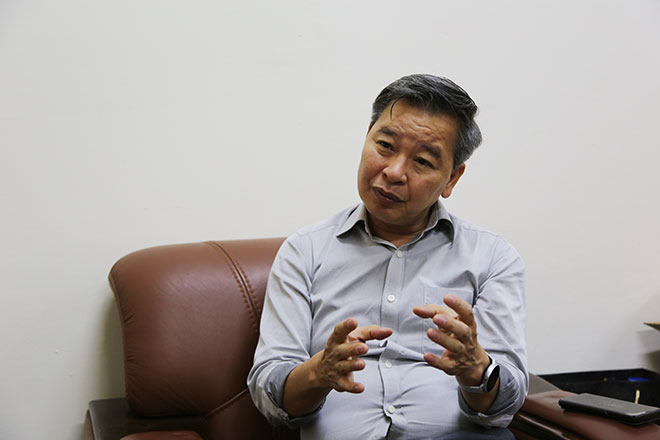
After all, how exactly should the Western model of liberal democracy be understood? And is it a normative model to which all political systems in the world must aspire?
This is a question that humanity has been asking fiercely since the late 90s of the last century, when the socialist system in Eastern Europe collapsed, and many people thought that the "bipolar order" had turned into a "unipolar order", but now it seems that things are not happening like that. Professor Dr. Pham Quang Minh, a political scientist and international relations researcher, has many in-depth research works on this issue. He accepted to participate in the "Dialogue & Reflection" column of ANTG GT - CT to share with readers his research, from many different perspectives.
-Journalist Phan Dang: Professor, before discussing the characteristics of the Western model of liberal democracy, we must talk about the time of its “rise to power”. In my opinion, it “rise to power” at the time when the socialist system in Eastern Europe collapsed, right?
- Prof. Dr. Pham Quang Minh:In the second half of the 1980s, the world witnessed structural and global changes. It was the end of the Cold War, followed by the collapse of the Soviet Union, the collapse of the people's democracy in Eastern European countries and the bipolar world order that had existed for more than 50 years since World War II (1947-1989).

Witnessing such shocking changes, in 1989, Professor Francis Fukuyama proposed a theory about the so-called "The End of History" published in the magazine "The National Interest".
According to Fukuyama, with the collapse of the Soviet Union and the bipolar order, humanity witnessed the end of ideological evolution and the triumph of Western liberal democracy as the ultimate model of human governance in the long term.
But, looking back at what happened from the late 70s and mid 80s until now, when socialist countries in general, especially China and Vietnam, have carried out reforms and opening up, implementing policies in line with the development trend of humanity, we see that things are not like that.
-Everyone knows that socialism was “transplanted” from Eastern Europe to East Asia, but in the end, reformed socialism in East Asia survived, while the original socialism in Eastern Europe died. If this is called the paradox of the times, then from the perspective of a political researcher, how do you explain this paradox?
- The crisis in Eastern Europe has many reasons but basically focuses on two main reasons: the inefficiency of collectivized agriculture and the inflexibility of the centralized economy. Although these two problems can help the state control and redistribute most of the general output, they hinder and even eliminate the motivation for production growth.
Therefore, in the socialist system, the state can only perform its role in the initial stage, and later on it becomes increasingly weak and backward compared to states with high economic growth.
Compared to Europe, the socialist countries in East Asia have a huge difference, which is that these countries have hardly experienced an industrial revolution in its true sense, so far, farmers still make up the majority of the population. In Vietnam alone, until 2019, the number of people living in rural areas still accounted for 65.6% of the population. According to many studies, the rural population is more sympathetic to the socialist regime. Studies in the Balkans also show that the majority of farmers continue to support the communist party in free elections.
Countries like China, Vietnam and North Korea all share a common feature that the government has closely combined the national liberation revolution with the people's democratic revolution. In China, unlike the Kuomintang, Mao Zedong's Communist Party succeeded in rallying forces, leading ethnic groups, and using the ethnic issue as a tool in World War II against Japanese fascism, so it received the support of the entire population.
Similarly, in Vietnam, the Indochinese Communist Party succeeded in combining communism and nationalism, creating a national strength in the war of national liberation and thus won, something that no other political party could do.
- That means the Communist Party here has great "legitimacy"?
- That's right, legitimacy!
But if we only rely on "legitimacy/ legitimation", it is not easy to survive in the long term, so perhaps besides "legitimacy" which brings great initial advantages, perhaps the important thing also comes from the reforms and changes within it?
- There is an obvious trend: socialist countries in East Asia tend to learn or be influenced by neighboring countries, mainly from newly industrialized countries because of historical and cultural similarities such as Korea, Taiwan, Hong Kong, Singapore, Malaysia and Thailand.
- What exactly do they learn, sir?
- They thoroughly learn the authoritarian democratic model of these newly industrialized countries, to lead a multi-sector economy or a socialist-oriented market economy. In addition, there is another very special factor that researchers often talk about, which is that China, Korea and Vietnam all share a common cultural heritage, Confucianism.
Because there are similarities between Confucianism and socialist ideology such as collectivism, the principle of hierarchy, the abandonment of organized religion, aversion to commerce, worship of the gentleman intellectual who sacrifices personal interests to serve and guide the people. Both Confucianism and East Asian socialist countries emphasize stability, harmony, and avoid pluralism and multi-party system because of concerns that conflicts and contradictions can easily lead to instability and collapse.
- Now let's return to the question I raised at the beginning of this dialogue, which is the basic characteristics of Western liberal and democratic values. From the perspective of a researcher, can you tell us exactly how we should understand these values?
- First of all, it must be seen that the level of democracy in world politics is divided into 3 types by researchers. The first is liberal democracy, the second is authoritarian democracy and the third is autocracy, with no democracy at all. So what is a liberal democracy?
The most important characteristic of a liberal democracy is that there must be competition for power in regular elections. And this competition must be fair. If you analyze this fair characteristic carefully, you will see that there is no such thing as “the winner becomes king - the loser becomes a bandit” as a familiar saying of the Vietnamese people.
- (Laughs...). Because losing doesn't mean being the enemy!
- (Also laughs...). That's right! In this case, it should be: The winner is king - the loser is the opponent.
- This sentence is great.
- Because of that mindset, we understand why after losing an election, the loser still calls to congratulate the winner. People understand that in this fair race, the loser loses, but after 4 or 5 years (depending on the country), when the term ends, they will have the opportunity to continue the race.
- What else is special about this type of democracy?
- The second characteristic of this model is that in society there must always be "social action groups" that operate freely and have the ability to influence the policy-making process, the most typical example of which is the activities of unions, lobby groups, social activities...
- The state only guides and creates basic legal frameworks, but does it leave the market to operate and regulate?
- I once wrote a sentence that is considered the most important in my research topic: "A good government must be a government that interferes the least". But now, for example, if an accident happens, the prime minister is called, a fire happens, the prime minister is called, a bad investment happens, the prime minister is called, everything is called and the prime minister is waited for to be guided, then how can the prime minister have time and energy to solve macro problems? If the prime minister has to do that, the government has to do that, the state has to operate that, then it proves that the state apparatus is ineffective.
- In this model, is it certain that the state economy is not the driving force, not the focus?
- There are three factors that govern an economy: the state, the market, and society. There was a time when we in Vietnam were worried that the state economy would lose its role, so we emphasized state ownership or collective ownership and neglected the private sector. State economic groups have many privileges in terms of land, capital, and other priorities. As a result, we all know that their operations are not as effective as expected.
- But now we have changed and consider the private economy as the driving force.
- (Nodding). That is a welcome change. With this change, I suddenly remember the time of the liberation of the South in 1975. Immediately after the liberation, we raised the question: is it possible to build a model of one state with two regimes?
- That means the North still follows socialist economy but the South experiments with market economy?
- That's right, because the economic and social characteristics in the South are very different. But then, this was not approved. We brought the economic model of the North there, collectivized agriculture, reformed industry and commerce, and so the economy operated inefficiently for a very long time.
- By the way, the professor is thinking back to a story from the past, so I would like to take the liberty to try to think back in another way: suppose at that time we let the South experiment with the market economy, what would the big brother of the socialist bloc, the Soviet Union, think? Would he agree and support us?
- Actually, even before that, during the resistance war against the US, the Soviet Union itself only wanted us to resolve everything through peaceful negotiations, not through military force. China wanted Vietnam to have a long-term resistance war because they wanted the US and the Soviet Union to be drawn into this war. But we still have our own way.

Prof. Dr. Pham Quang Minh talks with reporters of Traffic and Traffic Safety Special Topic.
- I have read some fairly reliable documents saying that at that time, First Secretary Le Duan once said: if we want to fight America, we must not only not be afraid of America, but also not be afraid of the Soviet Union or China. Because if we "have no fear", we can navigate between the big countries, with their intertwined interests and calculations in the most reasonable and beneficial way for ourselves.
- So at that time, it must be said that our way of going was relatively independent. Going back to the story of one state, two systems, creating a period of time for the Southern economy to develop in its own way, that is, creating a gap for the two rails to fit together, then who knows, maybe the Northern economy would also change positively afterwards. Of course, history has no room for "if", but when looking back at history, we still have to "if" to see that choosing institutions and development models is extremely important for a country.
- The professor has just analyzed the economic development model in liberal democratic states. Is there anything else that needs attention in this type of state?
- Liberal democracy has another characteristic, besides being a democracy where the basic rights of the people are respected, such as freedom of speech, freedom of movement, freedom of education... there is a fifth characteristic, which is that the government is run by civilian forces. You look at even the defense minister of many countries, he is a completely civilian figure, not necessarily a general with stars and stripes. Mrs. Inada Tomomi, the current Defense Minister of Japan, is a lawyer.
- If we look at some of the characteristics that the professor just mentioned, most East Asian countries, including Vietnam, do not belong to this liberal democratic model. Perhaps we are at the second level, authoritarian democracy?
- Actually, we translate this second level of democracy into Vietnamese in many different ways. Some people translate it as authoritarian democracy, some translate it as centralized democracy, and some translate it as collective democracy. Personally, I think it can be called a soft authoritarian democracy model. And according to our research, this model, not the Western-style liberal democracy model, is very suitable for East Asian societies, including Vietnam. Because the social, economic, cultural and political foundations of Asian countries are very different from those of the West.
Just to cite one thing, the feudal system in many Asian countries lasted until the first half of the 20th century, while in many Western countries it only existed until the mid-18th-19th century. Building any development model must depend on its own cultural and social factors, and cannot be applied mechanically, according to some fixed standard from outside.
- I sympathize with the professor's point of view because it can be said like this: looking at the neighbor's house, we see the neighbor wearing a very nice shirt. But, if we also sew the same shirt as the neighbor to wear for the members of our family, it may create a huge aesthetic gap. But, professor, that does not mean we should stubbornly keep what we have without changing, without reforming according to the development trend of the times, right? We may not sew a shirt exactly like the neighbor's shirt, but we must understand the principles and trends to be able to create a beautiful shirt that best suits us.
- There are many things we have to change, to move towards a harmonious and sustainable social development governance model. We have done very in-depth research on this, in which we can briefly and easily say that: we have to convert the management model to an administrative model.
- What is the difference between management and administration, sir?
- Theoretically speaking, management is doing the right things, while administration is doing the right thing. Management is reactive, reactive; administration has a strategic vision. Management is hand-holding, leading everything, not creating space for people to work and be creative; administration only creates a legal corridor, and leaves specific movements to people to do themselves.
- Management is clearly a different horizon?
- (Nods). Governance is often mentioned in contexts where the state may not hold a particularly dominant position. Governance emphasizes the transformation and reduction of traditional institutional power of the government in two directions: first, to transfer to transnational and regional institutions/entities, such as ASEAN, and second, to transfer to other entities such as civil society organizations and businesses.
In a broad sense, social governance is the process by which governments, social organizations, businesses, communities, and individuals are equal partners in regulating and managing social issues. In the process of governance, the powers of government, the market, and society coexist.
- So there are 3 big pillars in the governance model: State - Market - Social organizations and Individuals, does it destroy the classical governance model which has only 1 pillar: the state?
- In today's context, if human resources, financial resources, and facilities for solving social problems mainly come from the state, it will lead to a lack of resources to adequately solve social problems. Therefore, it is necessary to supplement resources from the market, that is, businesses, individuals, and social organizations. This mechanism will maximize resources to solve increasingly diverse social problems.
In addition, the model of State - Market - Social organizations and Individuals in social development management also helps to organize and implement policies effectively. If only the State takes charge of all stages, processes and tasks, then shortages and losses of financial resources are likely to occur due to lack of effective supervision.
- Professor, throughout this dialogue, I understand one of your ideas: we still maintain our core principles, but to develop in an integrated and changing world, there must be changes, the most obvious of which is the shift from a social management model to a social governance model, right?
- In my opinion, institutional innovation must be comprehensive and in addition to what has just been discussed, I would like to add that such innovation must be associated with the process of improving institutional accountability, transparency and predictability.
- We hope that in the future we will have the opportunity to hear the professor continue to analyze these very important innovation factors. Thank you very much, professor!
According to ANTG
Author:Phan Dang (performed) - Photo: Trong Nghia
Newer news
Older news